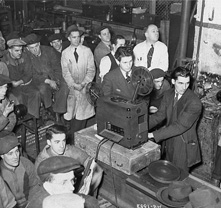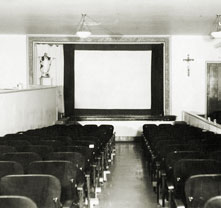16mm Exhibition Circuits
-

The Royal theatre in Cabano, managed by Robert Breton.
Source : Collection Pierre Pageau
-

Travelling NFB film screenings.
Source : Cinémathèque québécoise, 2008.0144.1.PH
-

Religion was a powerful presence in this parish hall fitted out for film screenings.
Source : Pierre Pageau
Beginnings
Although itinerant projectionists had begun using the new 16mm format in the mid-1920s, the distribution of film in 16mm only became widespread in 1935, with the founding in Ottawa of the National Film Society, a federation of film societies. In 1950, the Society became the Canadian Film Institute/L’Institut canadien du film.
Distribution
Nineteen thirty-five was also the year in which large American producers began to distribute some of their films in 16mm. From 1942 on, three companies shared the distribution of 16mm American films in Canada: France-Film, General Films and Sovereign Films, the latter an Alberta-based company. Beginning in 1946, these distributors also offered versions of their films dubbed into French.
A small distributor, J.A. Lapointe Films, managed to carve out a space alongside these larger companies. Founded in 1949 by J.A. Lapointe and his wife Marguerite, the company acted as an intermediary between 16mm film distributors and the schools and parish organisations which wished to show films. Lapointe also benefited from the emergence of film societies at the turn of the 1950s. He distributed films by major world filmmakers (including Kurosawa, Kobayashi, Tati and Bresson) alongside more commercial fare produced by large American companies. Lapointe made a special effort to provide viewers in Quebec with original versions of films, subtitled in French.
Religious Film Distribution Circuits
In Quebec, 16mm film distribution was principally carried out by members of the Church active in education. Even though they were sometimes equipped with 35mm projection facilities, the many school and community screening venues run by religious communities in Quebec most often used 16mm films throughout the 1940s, 50s and 60s. Many colleges, convents and parishes obtained their films from France-Film, which in 1939 had acquired the 16mm distribution rights to many films in its catalogue. Prints of these films were produced in the laboratories of Associated Screen News.
As it turns out, many village priests turned out to be astute businessmen. Some, for example, discovered that they could recover a part of the $25 rental fee paid to France-Film by subletting the film to a neighbouring village for $10 before shipping it back to Montreal in the mail. In this way, a good share of their revenues became profits.
Many proprietors of commercial movie theatres, however, saw these 16mm screenings as a form of unfair competition. In some small towns, the owner of the local cinema sometimes tried to bribe the parish priest by promising him edifying films or commissions for the Church. In Cabano, a fierce struggle took place between the “movie theatre of the priest”, Father Cyr, and Robert “Robby” Breton’s Théâtre Royal. Against all odds, Father Cyr won the day and offered his flock a very dynamic program from 1922 to 1962.
In 1945, Quebec Allied Theatrical Industries, the professional association of Quebec movie theatres, voted to ask the provincial government to prohibit public screenings of 16mm films within a radius of 10 miles of a commercial movie theatre. The government did not grant their request. Nevertheless, in 1947 the federal government imposed an excise tax on 16mm film screenings.
Government Exhibition Circuits
Governments were also interested in distributing 16mm films. The National Film Board operated a very effective distribution network between 1945 and 1955. NFB employees criss-crossed Quebec with thirteen vans equipped with projection materials. In addition to this activity, reminiscent of the early itinerant projectionists, the NFB supported a large network of film libraries.
In 1941 the Quebec government, for its part, founded the Service de Ciné-photographie, which used mostly 16mm in its educational film programs. The Office du tourisme et de publicité du Québec had begun to carry out similar work in the silent film era. In 1947, a municipal film library was founded under the aegis of the Montreal public library. It made a large collection of 16mm films available to all, including children’s films and classics which were of great use to film teachers. At a time when children were not always allowed into commercial movie theatres, these initiatives significantly broadened the public’s access to films.
Censorship of 16mm Films
Even though films in 16mm had existed in Quebec since the 1920s, the Bureau de censure was not interested in these films. Thus 16mm film prints, which were sometimes called “miniatures”, occasionally contained scenes that had been cut from 35mm prints shown in commercial movie theatres. Only in 1947 did the Duplessis government pass a law subjecting 16mm films to censorship. The motives of Duplessis and his officials appear to have been both moral and political. With this measure, he hoped to hinder the distribution of NFB films, which he accused of propagating communist and centralist ideas.
The Arrival of Television
In the mid-1940s, a few commercial movie theatres began to use 16mm films, which became particularly popular in film society screenings in the 1960s. Television in its early years in the 1950s also used 16mm widely, both for news reports and to broadcast films.
The end, or almost, of regular 16mm screenings in parish halls, especially in remote areas, came on 6 August 1965, when the Quebec National Assembly voted in favour of a new “Parish law” which prohibited parishes from operating, even on a non-profit basis, leisure facilities such as movie theatres and bowling alleys, which they had been doing for decades.